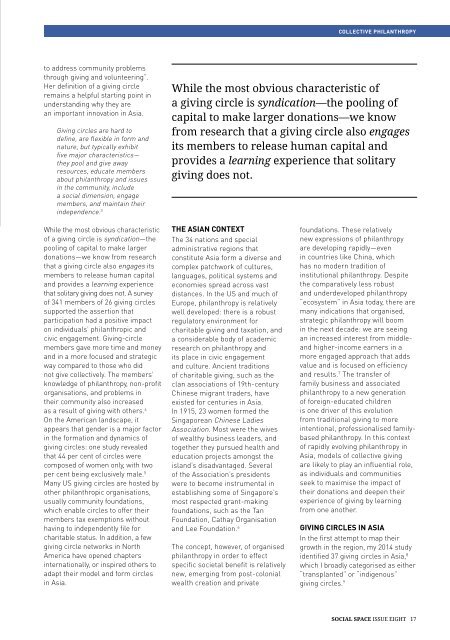Social Space (Issue 8, 2016-2017) - The Social Finance Issue
Since its debut in 2008, Social Space, the bi-annual flagship publication of the Lien Centre for Social Innovation at Singapore Management University, has provided a platform for local and international practitioners and thought leaders to share their perspectives on social innovation and entrepreneurship. Available in print and online (http://www.socialspacemag.org).
Since its debut in 2008, Social Space, the bi-annual flagship publication of the Lien Centre for Social Innovation at Singapore Management University, has provided a platform for local and international practitioners and thought leaders to share their perspectives on social innovation and entrepreneurship. Available in print and online (http://www.socialspacemag.org).
You also want an ePaper? Increase the reach of your titles
YUMPU automatically turns print PDFs into web optimized ePapers that Google loves.
Collective Philanthropy<br />
to address community problems<br />
through giving and volunteering”.<br />
Her definition of a giving circle<br />
remains a helpful starting point in<br />
understanding why they are<br />
an important innovation in Asia.<br />
Giving circles are hard to<br />
define, are flexible in form and<br />
nature, but typically exhibit<br />
five major characteristics—<br />
they pool and give away<br />
resources, educate members<br />
about philanthropy and issues<br />
in the community, include<br />
a social dimension, engage<br />
members, and maintain their<br />
independence. 3<br />
While the most obvious characteristic of<br />
a giving circle is syndication—the pooling of<br />
capital to make larger donations—we know<br />
from research that a giving circle also engages<br />
its members to release human capital and<br />
provides a learning experience that solitary<br />
giving does not.<br />
While the most obvious characteristic<br />
of a giving circle is syndication—the<br />
pooling of capital to make larger<br />
donations—we know from research<br />
that a giving circle also engages its<br />
members to release human capital<br />
and provides a learning experience<br />
that solitary giving does not. A survey<br />
of 341 members of 26 giving circles<br />
supported the assertion that<br />
participation had a positive impact<br />
on individuals’ philanthropic and<br />
civic engagement. Giving-circle<br />
members gave more time and money<br />
and in a more focused and strategic<br />
way compared to those who did<br />
not give collectively. <strong>The</strong> members’<br />
knowledge of philanthropy, non-profit<br />
organisations, and problems in<br />
their community also increased<br />
as a result of giving with others. 4<br />
On the American landscape, it<br />
appears that gender is a major factor<br />
in the formation and dynamics of<br />
giving circles: one study revealed<br />
that 44 per cent of circles were<br />
composed of women only, with two<br />
per cent being exclusively male. 5<br />
Many US giving circles are hosted by<br />
other philanthropic organisations,<br />
usually community foundations,<br />
which enable circles to offer their<br />
members tax exemptions without<br />
having to independently file for<br />
charitable status. In addition, a few<br />
giving circle networks in North<br />
America have opened chapters<br />
internationally, or inspired others to<br />
adapt their model and form circles<br />
in Asia.<br />
THE ASIAN CONTEXT<br />
<strong>The</strong> 34 nations and special<br />
administrative regions that<br />
constitute Asia form a diverse and<br />
complex patchwork of cultures,<br />
languages, political systems and<br />
economies spread across vast<br />
distances. In the US and much of<br />
Europe, philanthropy is relatively<br />
well developed: there is a robust<br />
regulatory environment for<br />
charitable giving and taxation, and<br />
a considerable body of academic<br />
research on philanthropy and<br />
its place in civic engagement<br />
and culture. Ancient traditions<br />
of charitable giving, such as the<br />
clan associations of 19th-century<br />
Chinese migrant traders, have<br />
existed for centuries in Asia.<br />
In 1915, 23 women formed the<br />
Singaporean Chinese Ladies<br />
Association. Most were the wives<br />
of wealthy business leaders, and<br />
together they pursued health and<br />
education projects amongst the<br />
island’s disadvantaged. Several<br />
of the Association’s presidents<br />
were to become instrumental in<br />
establishing some of Singapore’s<br />
most respected grant-making<br />
foundations, such as the Tan<br />
Foundation, Cathay Organisation<br />
and Lee Foundation. 6<br />
<strong>The</strong> concept, however, of organised<br />
philanthropy in order to effect<br />
specific societal benefit is relatively<br />
new, emerging from post-colonial<br />
wealth creation and private<br />
foundations. <strong>The</strong>se relatively<br />
new expressions of philanthropy<br />
are developing rapidly—even<br />
in countries like China, which<br />
has no modern tradition of<br />
institutional philanthropy. Despite<br />
the comparatively less robust<br />
and underdeveloped philanthropy<br />
“ecosystem” in Asia today, there are<br />
many indications that organised,<br />
strategic philanthropy will boom<br />
in the next decade: we are seeing<br />
an increased interest from middleand<br />
higher-income earners in a<br />
more engaged approach that adds<br />
value and is focused on efficiency<br />
and results. 7 <strong>The</strong> transfer of<br />
family business and associated<br />
philanthropy to a new generation<br />
of foreign-educated children<br />
is one driver of this evolution<br />
from traditional giving to more<br />
intentional, professionalised familybased<br />
philanthropy. In this context<br />
of rapidly evolving philanthropy in<br />
Asia, models of collective giving<br />
are likely to play an influential role,<br />
as individuals and communities<br />
seek to maximise the impact of<br />
their donations and deepen their<br />
experience of giving by learning<br />
from one another.<br />
GIVING CIRCLES IN ASIA<br />
In the first attempt to map their<br />
growth in the region, my 2014 study<br />
identified 37 giving circles in Asia, 8<br />
which I broadly categorised as either<br />
“transplanted” or “indigenous”<br />
giving circles. 9<br />
<strong>Social</strong> <strong>Space</strong> ISSUE EIGHT 17


